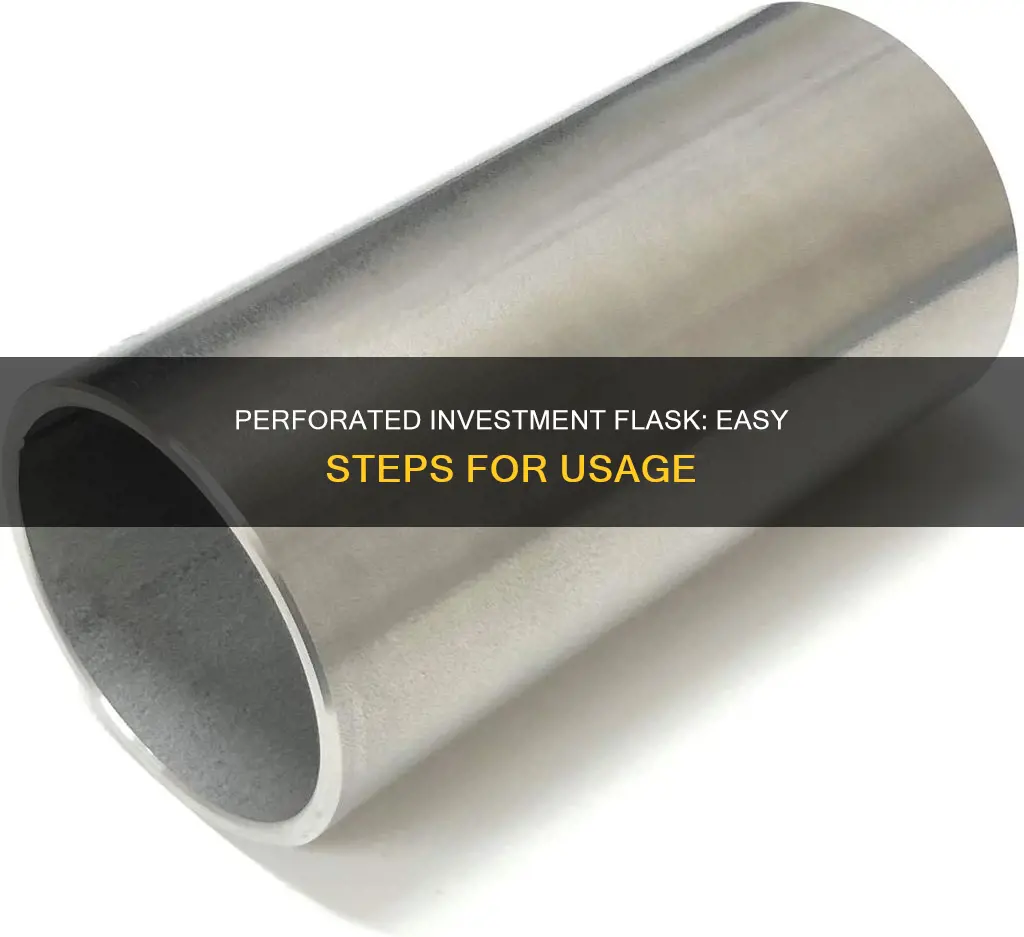
Perforated investment flasks are used in the vacuum casting process for jewellery making. They are metal cylinders, which are secured into a sprue base surrounding a wax model. The flask is then filled with a plaster-like mixture called an 'investment'. After the investment hardens, the flask is placed into a burnout furnace, where the temperature rises from 300°F to 1350°F. During this period, the wax model is lost, leaving a cavity in the investment. The flask is then placed into a casting machine, where metal is melted and cast. Perforated flasks are particularly useful for this process as the holes on the sides help to ensure a more perfect cast since the molten metal is forced into cavities from all directions.
| Characteristics | Values |
|---|---|
| Used in | Vacuum casting process |
| Use | Allow vacuums to pull unwanted gas through the investment wall |
| Use | Help ensure a more perfect cast |
| Use | Force molten metal into cavities from all directions |
| Used with | Chamber-style vacuum casting machines |
| Wall thickness | 3mm (10 SWG gauge) |
| Feature | Cross bar on top to prevent warping |
What You'll Learn
- How to use a perforated investment flask with a vacuum casting machine?
- How to use a perforated investment flask with a centrifugal casting machine?
- How to prepare a perforated investment flask for casting?
- How to clean a perforated investment flask?
- How to choose the right perforated investment flask for your needs?

How to use a perforated investment flask with a vacuum casting machine
Using a perforated investment flask with a vacuum casting machine requires several steps and a lot of care. Here is a detailed guide on how to do it:
Step 1: Prepare the Investment Flask
Firstly, you will need to prepare your perforated investment flask. This includes ensuring that the investment has been scraped even and level with the edges of the bottom of the flask. It is also recommended to hollow or cup the investment slightly to ensure a good seal. This is crucial for achieving successful casts.
Step 2: Prepare the Vacuum Casting Machine
Before beginning the casting process, you need to ensure that your vacuum casting machine is set up correctly and functioning properly. This includes filling the vacuum pump with the correct type and amount of oil, as well as testing both the vacuum investing table and the vacuum casting chamber to ensure they are working correctly and achieving a full vacuum. Refer to the machine's instructions for specific details on these steps.
Step 3: Prepare the Crucible
The crucible is the container that holds the molten metal during the casting process. It is important to prepare it properly to ensure the best results. Use a ceramic melting dish with a handle, which is supplied with most units. To improve its usability and pourability, glaze the crucible by making a thin paste of borax and melting it with a torch to form a hard glazed lining inside. It is recommended to use separate crucibles for different metals, such as silver, yellow gold, and white gold.
Step 4: Understand the Vacuum Gauge
The vacuum gauge on your machine indicates the vacuum in inches of mercury being pulled by the pump. This gauge depends on atmospheric pressure, which is typically 29.9 inches of mercury or 14.7 pounds per square inch at sea level. If you are at a higher altitude, the vacuum reading will be proportionally lower. Refer to a vacuum gauge chart to interpret the correct vacuum reading for your location.
Step 5: Mix the Investment Powder and Water
Following the manufacturer's recommendations, measure the correct amount of water and pour it into a mixing bowl. Then, weigh the correct amount of investment material and introduce it into the water. Stir the water and investment together for 2 to 3 minutes, ensuring that the mixture (slurry) is smooth and free of lumps.
Step 6: Apply Vacuum to the Investment Mixture
Place the mixing bowl containing the slurry on the vacuum table and cover it with the plastic bell jar. Turn on the vacuum pump and set the vacuum control knob to the "INVESTMENT TABLE" position. The reduced air pressure under the bell jar will cause the entrapped air in the investment to be released and rise to the surface. The investment slurry will also rise. If this happens, tap the corner of the vacuum table sharply to lower the slurry level. After about 90 seconds, release the vacuum and turn off the pump. Never turn off the pump before releasing the vacuum, as this can cause oil to be sucked up into the table.
Step 7: Pour the Investment Mix into the Flask
Now, carefully pour the investment mix into your prepared flask. When using a conventional, solid-wall flask with vacuum assistance, it is recommended to use a flask extender made of preformed rubber and placed around the top of the flask to prevent investment overflow during vacuuming. This allows you to pour the investment to the top of the flask. If you are using a perforated flask, cover the flask perforations with flask jackets made of preformed rubber.
Step 8: Vacuum the Invested Flask
Place the filled flask under the bell jar and activate the pump. Set the vacuum control knob to the "INVESTING TABLE" setting and ensure a secure seal between the bell jar and rubber pad. Vacuum the invested flask for approximately 1-1/2 minutes at full vacuum (29 inches at sea level). Be careful not to over-vacuum the investment, as this can remove too much water from the slurry. You can lightly tap the spring-supported vacuum table to help release bubbles from the flask during this process.
Step 9: Allow the Invested Flask to Set
Let the invested flask sit for about 2 hours before beginning the burnout procedure. This step is crucial for the investment to harden and prepare for the casting process.
Step 10: Choose Your Casting Method
There are two main casting methods you can use with a vacuum casting machine: the vacuum chamber casting procedure and the vacuum-assist casting procedure. The vacuum chamber method requires the use of perforated flasks, while the vacuum-assist method can be used with standard solid-wall flasks or perforated flasks. Choose the method that suits your specific needs and follow the appropriate steps below.
Step 11A: Vacuum Chamber Casting Procedure (for Perforated Flasks)
Place the appropriate flask adapter ring on top of the recessed casting chamber to match your perforated flask size. Firmly seat the adopter plate over the seal if using a 3-3/8" or 4" flask. Align the silicon rubber ring on the adapter to form a tight vacuum seal. Ensure that the flask is placed through the hole in the adopter ring with the flange resting on the silicon seal, and the sprue end facing up. The flask should be cast at a temperature between 700°F and 1000°F, depending on the object being cast.
Turn on the vacuum pump and set the vacuum control knob to the "CASTING TABLE" position. The vacuum gauge needle should indicate a vacuum of 20 inches (at sea level) or more, showing a good seal between the flask and pad. Melt your metal in the handled crucible, fluxing as needed. When the metal is ready, pour it quickly and directly into the mold while the vacuum pump is running. After pouring, play the torch flame on the bottom of the button of the metal formed by the pour for a few seconds to ensure progressive solidification.
Once the cast is complete, release the vacuum by turning the vacuum control knob to the "VACUUM RELEASE" position and then turning off the pump. Allow the flask to cool for about 2 minutes before removing it from the pad. You can then remove the cast piece by quenching (cooling and knocking it out) or simply allowing the flask to cool and then knocking it out with a rawhide mallet. Be careful not to damage the flask, as you will need a good seal for your next cast.
Step 11B: Vacuum-Assist Casting Procedure (for Solid-Wall or Perforated Flasks)
For this method, place the 5" adapter seal on top of the recessed chamber, followed by the vacuum-assist adapter plate. Then, place the 7" diameter silicon pad on top of the adapter plate, with the 1/2" hole directly over the hole in the plate. Position your flask so that its center is directly over the 1/2" hole, ensuring a good seal by using a flask with smooth, even edges. Note that the flask should be cast at a temperature between 700°F and 1000°F, depending on the object being cast, with thinner objects requiring higher temperatures and thicker objects requiring lower temperatures.
Turn on the vacuum pump and set the vacuum control knob to the "CASTING TABLE" position. Again, the vacuum gauge needle should indicate a vacuum of 20 inches (at sea level) or more, showing a good seal. Melt your metal in the handled crucible and flux as needed. When the
Cash on Hand: Strategic Investing and Opportunities
You may want to see also

How to use a perforated investment flask with a centrifugal casting machine
Using a perforated investment flask with a centrifugal casting machine is a complex process that requires careful preparation and multiple steps. Here is a detailed guide on how to use a perforated investment flask with a centrifugal casting machine:
Step 1: Prepare the Wax Model or Pattern
Firstly, you will need to create a wax model or pattern of the object you wish to cast. This can be done using wax or any completely combustible material. Ensure that the model is free of any defects and make any necessary repairs. The more finished your model is, the less cleanup will be required for the final casting. You can also create rubber moulds of original pieces and use them to make wax models for copies.
Step 2: Assemble the Wax Patterns
If you are creating multiple wax patterns, they can be assembled into a tree-like structure. Attach the patterns to a wax sprue, creating a pattern cluster. Use a heating tool to melt designated wax surfaces slightly, then press them together and let them cool and harden. You can assemble as many patterns as needed onto the tree. Ensure that the sprue for each model is kept as short as possible.
Step 3: Mount the Wax Tree
Mount the wax tree onto a rubber sprue base. Melt wax where the sprue wax and the sprue base meet, using an alcohol lamp and a large sewing needle. Commercial wax pens are also available for this purpose.
Step 4: Prepare the Flask and Sprue Base
Purchase a flask and sprue base set. Ensure the flask has a large enough diameter to allow a clearance of at least 3/8" between the model and the flask wall. The flask should also be tall enough to allow for at least 1/2" of investment to cover the model. Inadequate investment can lead to a blowout, which can be dangerous when using a centrifugal machine.
Step 5: Calculate the Amount of Metal Needed
Weigh and mark the rubber sprue base. Subtract the weight of the sprue base from the total weight of the sprue base, model, and sprues. This will give you the weight of your models and sprues. To determine the amount of metal needed, use the following formula:
> The amount of metal needed to fill the mold = (W x SGw x SGm) + 15.55 grams
Where:
- W = Grams of wax or other model medium
- SGw = Specific gravity of wax or other model medium
- SGm = Specific gravity of metal used for casting
Step 6: Mix the Investment
Follow the manufacturer's instructions for mixing and measuring the investment. Powder should be measured by weight, while fluid should be measured by volume. It is crucial to wear a good particle mask during this step to protect yourself from dust and fumes. After mixing, vibrate the mixing bowl on a vibrating platform to eliminate bubbles in the model and the investment.
Step 7: Pour the Investment into the Flask
Slowly pour the investment into the flask while tilting it. Ensure you have enough investment to fill the flask completely in one pour. Vibrate the flask again to remove any remaining bubbles. Let the investment set and scratch an identity mark on it.
Step 8: Burn-out and Preheat
Place the flasks into a kiln and follow a "burnout schedule" based on the size of the flasks. Turn off the kiln at the end of the burnout cycle and let the flasks cool to 300 to 400 degrees below the melting point of the metal you are using. Preheat the crucible and flux it.
Step 9: Centrifugal Casting
Place the hot flask into the centrifugal casting machine, ensuring proper alignment. Slide the crucible towards the flask opening and melt the metal. Check the melt for lumps and remove any impurities. When the metal is ready, release the casting arm in a smooth movement and let the machine stop spinning. Remove the flask from the machine and place it on a fire-resistant surface until it cools down.
Step 10: Quench and Clean the Castings
Use tongs to quench the flasks in a bucket of water. This will remove the castings from the investment. Scrub the castings with a toothbrush to remove any remaining investment. Cut the castings and their sprues from the tree and clean up the area.
Additional Tips:
- Always measure the height of the trees before investing to prevent investment blowout.
- Dip the tree in a debubblizer to reduce surface tension and prevent air bubbles from forming nodules on the casting.
- Properly position the tree in the flask, leaving ample space between the outermost part of the pattern and the sidewall of the flask.
- When using a perforated flask, it can be filled completely, and the tree height can be lengthened accordingly.
Zinser Investment: Relevant Cash Flows and Their Impact
You may want to see also

How to prepare a perforated investment flask for casting
A perforated investment flask is a metal cylinder used in the lost-wax casting process. Here is a step-by-step guide on how to prepare a perforated investment flask for casting:
Step 1: Prepare the Wax Model
Firstly, create a wax model of the desired design. Ensure that the wax is finished to a high standard, as this will reduce the time needed for finishing the casting. Attach a sprue, which is an extruded wax wire, to the model. The sprue holds the wax model in place, provides an escape route for the wax, allows an entrance for the metal to be poured into the cavity, and aids in the proper solidification of the metal.
Step 2: Attach the Wax Model to a Sprue Base
Use a sticky wax adhesive to attach the sprue to a rubber sprue base. Ensure that the union is secure and completely sealed. Leave a minimum space of 4 millimetres between the models and the wall of the flask.
Step 3: Mix the Investment Powder
Mix the investment powder with water at room temperature. The amount of investment powder and water used is crucial to the success of the process. Use a rubber mixing bowl and introduce the powder to the water gradually. Mix the slurry slowly and thoroughly to avoid accelerating the setting time. Once the powder and water are combined, use a vacuum machine to remove any air from the mixture.
Step 4: Fill the Perforated Flask
After mixing the investment powder and water, slowly pour the slurry into the perforated flask, making sure to cover the wax models completely. Fill the flask to approximately half an inch from the top to prevent spillage during the next step.
Step 5: Remove Air from the Flask
Place the filled flask on a vacuum machine and cover it with a bell jar. Turn on the machine and extract the air, ensuring that all trapped air is removed from the flask. This step is crucial, as it allows the molten metal to fill the cavity during casting.
Step 6: Allow the Investment to Harden
Once the air has been removed, set the flask aside and allow the investment to harden for at least 30 minutes. During this time, do not disturb the flask, as the investment could crack. After hardening, remove the rubber sprue base.
Step 7: Burnout the Wax
Place the flask in a burnout oven to eliminate the wax from the flask. This step is important to ensure that the wax does not create an acrid odour or harm the burnout oven. Set the oven temperature between 300°F and 1350°F. The wax will melt and leave a coating that will carbonize and turn to smoke, leaving a clean cavity.
Step 8: Casting
After the wax has been burned out, the flask is ready for casting. Place the flask in a vacuum assist casting machine or a centrifugal casting machine. Fill the crucible with the desired metal and heat it to the proper casting temperature. For the vacuum assist casting machine, pour the molten metal into the flask quickly, ensuring that the air is displaced and the cavity is filled. For the centrifugal casting machine, follow the balancing and winding procedures before releasing the arm to cast.
Step 9: Quench and Clean the Casting
After casting, quench the flask in a bucket of water, especially if casting white gold. The investment will break away from the casting, leaving some residue. Clean the casting with a brush or an investment-removing solution to remove any remaining investment.
Healthcare News: Your Investment Guide
You may want to see also

How to clean a perforated investment flask
To clean a perforated investment flask, you'll need to follow a few simple steps. Here is a detailed guide:
Step 1: Rinse the Flask
It is important to rinse your flask regularly, especially after each use. This will help prevent any residue buildup and make the cleaning process easier. Fill your flask with warm water and a mild detergent or dish soap. You can also use vinegar and water to eliminate any lingering odours. Shake the flask vigorously for at least 20 seconds to ensure the interior is thoroughly cleaned.
Step 2: Soak the Flask
For a deeper clean, you can fill the flask with a solution of warm water and a few spoonfuls of rice, salt, or baking soda. The abrasive nature of these ingredients will help scrub away any stubborn residue. Soak the flask for a few minutes, and then shake it vigorously to ensure all areas are cleaned.
Step 3: Brush the Interior
If there are any stubborn stains or residue, use a soft bottle brush to scrub the interior of the flask. A baby bottle brush is ideal for this purpose. Be gentle and avoid using abrasive brushes or sponges, as they may scratch the surface of the flask.
Step 4: Rinse and Dry
After brushing, rinse the flask thoroughly with warm water to remove any soap or cleaning solution residue. You can fill the flask with clean water and let it overflow to ensure a complete rinse. Finally, leave the flask uncapped and upside down on a clean towel to air dry completely. You can also use a paper towel to absorb any remaining moisture.
Additional Tips:
- Avoid using chlorine bleach or abrasive cleaners, as they may damage or scratch the flask.
- For stainless steel flasks, warm water and a mild detergent are usually sufficient for cleaning.
- If your flask is made of silver or pewter, use a polish specifically designed for these metals and follow the manufacturer's instructions.
- For leather flasks, avoid getting them excessively wet. Spot clean with a damp paper towel or use a specialised leather cleaner.
Cash and Sweep Investment: Maximizing Your Money
You may want to see also

How to choose the right perforated investment flask for your needs
Perforated investment flasks are used in the vacuum casting process. They are also known as casting flasks and are used in chamber-style vacuum casting machines. The perforations in the flasks allow vacuums to pull unwanted gas through the investment wall. The holes on the sides of the flasks help to ensure a more perfect cast since the molten metal is forced into cavities from all directions.
When choosing the right perforated investment flask for your needs, consider the following:
- The size of the flask: Perforated flasks come in various diameters and heights, so choose one that is suitable for the size of your casting.
- The type of casting: Perforated flasks are typically used for casting trees or large castings. If you are casting smaller items, a solid flask may be more suitable.
- The material of the flask: Perforated flasks are commonly made from stainless steel, which is strong and durable.
- The quality of the flask: Look for a well-welded flask that is pleasant to work with.
- The compatibility with your vacuum casting machine: Ensure that the flask you choose is compatible with your vacuum casting machine. Some machines require specific types or sizes of flasks.
- The cost: Perforated flasks can range in price, so consider your budget when making your choice.
By considering these factors, you can choose the right perforated investment flask that suits your specific needs and ensures successful castings.
Unlocking EPF Investments: A Guide to Smart Financial Planning
You may want to see also
Frequently asked questions
Perforated investment flasks are used in the vacuum casting process. The perforations allow the vacuum to pull the metal into the cavity, producing denser castings.
The holes on the sides of a perforated investment flask help ensure a more perfect cast since the molten metal is forced into cavities from all directions.
The perforated investment flask is filled with a mixture of a material called investment, which resembles plaster of Paris. After the investment hardens, the flask is placed into a burnout furnace where the temperature rises from 300°F to 1350°F. During this period, the wax model is lost, leaving a cavity in the investment. After dropping to a lower casting temperature, the flask is then placed into a casting machine, and metal is melted and cast.







